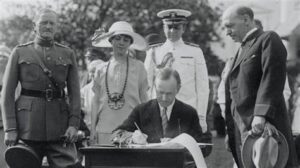 After World War I ended, war weary Americans decided that we needed to isolate ourselves from the rest of the world to a degree, in order to protect ourselves. Of course, that didn’t stop people from other countries from wanting to immigrate to the United States. The Johnson-Reed Immigration Act reflected that desire. Americans wanted to push back and distance ourselves from Europe amid growing fears of the spread of communist ideas. The new law seemed the best way to accomplish that. Unfortunately, the law also reflected the pervasiveness of racial discrimination in American society at the time. As more and more largely unskilled and uneducated immigrants tried to come into America, many Americans saw the enormous influx of immigrants during the early 1900s as causing unfair competition for jobs and land.
After World War I ended, war weary Americans decided that we needed to isolate ourselves from the rest of the world to a degree, in order to protect ourselves. Of course, that didn’t stop people from other countries from wanting to immigrate to the United States. The Johnson-Reed Immigration Act reflected that desire. Americans wanted to push back and distance ourselves from Europe amid growing fears of the spread of communist ideas. The new law seemed the best way to accomplish that. Unfortunately, the law also reflected the pervasiveness of racial discrimination in American society at the time. As more and more largely unskilled and uneducated immigrants tried to come into America, many Americans saw the enormous influx of immigrants during the early 1900s as causing unfair competition for jobs and land.
Under the new law, immigration was to remain open to those with a “college education and/or special skills, but entry was denied disproportionately to Eastern and Southern Europeans and Japanese.” At the same time, the legislation allowed for more immigration from Northern European nations such as Britain, Ireland, and Scandinavian countries. The law also set a quota that limited immigration to two percent of any given nation’s residents already in the US as of 1890, a provision designed to maintain America’s largely Northern European racial composition. In 1927, the “two percent rule” was eliminated and a cap of 150,000 total immigrants annually was established. While this was more fair all around, it particularly angered Japan. In 1907, Japan and US President Theodore Roosevelt had created a “Gentlemen’s Agreement,” which included more liberal immigration quotas for Japan. Of course, that was unfair to other nations looking to send immigrants to the United States. Strong US agricultural and labor interests, particularly from California, had already pushed through a form of exclusionary laws against Japanese immigrants by 1924, so they favored the more restrictive legislation signed by Coolidge.
Of course, the Japanese government felt that the American law as an insult and protested by declaring May 26  a “National Day of Humiliation” in Japan. With that, Japan experienced a wave of anti-American sentiment, inspiring a Japanese citizen to commit suicide outside the American embassy in Tokyo in protest. That created more anti-American sentiment, but in the end, it made no difference. On May 26, 1924, President Calvin Coolidge signed the Immigration Act of 1924 into law. It was the most stringent and possibly the most controversial US immigration policy in the nation’s history up to that time. Despite becoming known for such isolationist legislation, Coolidge also established the Statue of Liberty as a national monument in 1924.
a “National Day of Humiliation” in Japan. With that, Japan experienced a wave of anti-American sentiment, inspiring a Japanese citizen to commit suicide outside the American embassy in Tokyo in protest. That created more anti-American sentiment, but in the end, it made no difference. On May 26, 1924, President Calvin Coolidge signed the Immigration Act of 1924 into law. It was the most stringent and possibly the most controversial US immigration policy in the nation’s history up to that time. Despite becoming known for such isolationist legislation, Coolidge also established the Statue of Liberty as a national monument in 1924.


Leave a Reply